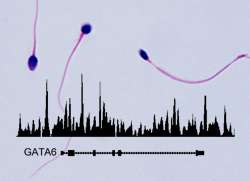The epigenetic influence of the father

(PhysOrg.com) -- Scientists from the Friedrich Miescher Institute for Biomedical Research (FMI) shed light on the highly debated question whether fathers transmit epigenetic information to their offspring. They have shown that the relatively few histones that bind and fold up DNA in mature human sperm carry specific covalent modifications and occupy specific sites in the genome.
The modified histones cluster around regulatory sequences of genes involved in early embryonic development, cellular homeostasis and spermatogenesis. This pattern is conserved from mouse to man, indicating that their distribution may indeed serve a specific function for regulating embryonic development and transmitting epigenetic information.
Not every inherited trait can be explained by the inheritance of genes. Tags on the genome, particularly those which are found in the form of post-translational modifications of histones, are thought to contribute to inheritance as well. These marks consist specifically of small methyl or acetyl groups covalently bound to highly conserved amino acids within histones. While the influence of maternal epigenetic marks on early embryonic development has been extensively studied, it has been hotly debated whether or not the father makes an epigenetic contribution as well. This is because the vast majority of histones are replaced by other proteins allowing denser packaging of the DNA during sperm maturation.
Antoine Peters and his team of epigenetic researchers at the Friedrich Miescher Institute for Biomedical Research show that there may indeed be a role for chromatin marks inherited from sperm in early mammalian development. In a recent report in Nature Structural & Molecular Biology they report that modified histones in mature human sperm predominantly bind to regulatory sequences of genes that are important for early embryonic development, cellular homeostasis and spermatogenesis. They found similar marks at the same classes of genes in sperm of mice; this conservation of epigenetic markings suggests that the positioning of paternal histone modifications may well be essential for controlling early embryonic development.
"A few other recent publications have examined the histones found in human sperm, but we are the first to show that positioning and modifications are conserved between species," comments Antoine Peters. "How modified histones are retained at these loci and whether they are part of an intrinsic transgenerational developmental program or also respond to environmental cues experienced by the father (for example, extreme starvation, stress or environmental toxins), is still unclear. Our results, however, definitely open new avenues of research into this important phenomenon."
More information: Nature Structural & Molecular Biology paper: www.nature.com/nsmb/journal/va … /full/nsmb.1821.html














